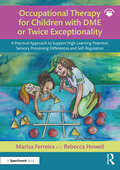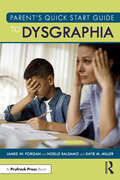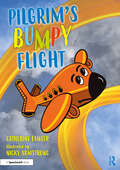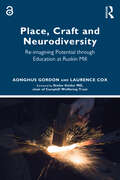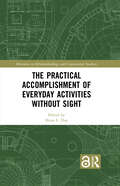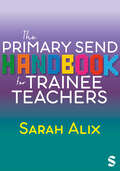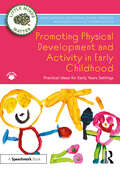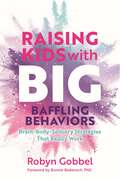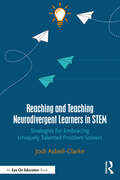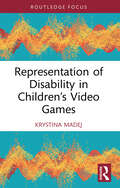- Table View
- List View
Occupational Therapy for Children with DME or Twice Exceptionality: A Practical Approach to Support High Learning Potential, Sensory Processing Differences and Self-Regulation
by Mariza Ferreira Rebecca HowellChildren with high learning potential or giftedness have remarkable potential. Despite this, these children can struggle to participate in everyday life because of a range of needs that are sometimes misunderstood, overlooked or not adequately addressed, leading to underachievement and, in turn, low self-esteem. Needs that, in many cases, paediatric occupational therapists are best suited to address. The practical resource offered in the book, the DME-C approach, is a tried-and-tested approach to help children who have challenges relating to their high learning potential, as well as sensory processing differences, unhelpful thought patterns and self-regulation. It draws on the heart of occupational therapy that considers the whole profile of the child, actively caters to the unique profiles of children with dual or multiple exceptionality (DME) or twice exceptionality (2e), and guides therapists towards therapy provision that is strengths-based and achieves favourable outcomes. This book: ● Includes a clear and comprehensive introduction to high learning potential and DME or twice exceptionality (2e), along with guidance to help identify children with these profiles. ● Covers questions and concerns occupational therapists may have when working with children with DME or 2e. ● Considers the similarities and differences between high learning potential/DME/2e and neurodivergent conditions such as developmental coordination disorder, autism and ADHD, with a focus on sensory processing differences. ● Explains, in easy-to-understand language, the full DME-C therapy approach, with a range of example activities to use in therapy to achieve its principles, and a suggested therapy progression plan. ● Is packed full of real-life case studies to translate theory into practice. ● Empowers therapists and educational professionals further by drawing attention to how they can better relate to children with DME/2e in therapy regardless of the children’s specific needs. Full of examples and with the voices of parents and children at its heart, this resource is essential reading for occupational therapists, SENCOs, education psychologists and other relevant professionals, who want to improve the lives and wellbeing of children with DME or twice exceptionality and help them reach their full potential.
Only Here, Only Now
by Tom Newlands'THE SCOTTISH BOOK OF THE SUMMER' HERALD 'This isn't just a great first novel; it's a great novel. And Cora, the mad, chaotic, wise, funny narrator, is one of the great characters'RODDY DOYLE'It's not every day you read a modern classic. But this feels destined to become one. A thunderous achievement'NATHAN FILER, author of THE SHOCK OF THE FALL'Only Here, Only Now heralds the arrival of an urgent and unique new voice'DAVID PEACEFife, in the blazing hot summer of 1994. Cora Mowat's mates don't understand her, but then Cora Mowat doesn't understand herself. She's stuck on a seaside council estate full of dafties, old folk and seagulls, with a thousand dreams and a restless brain that won't behave. She's dying to escape but unsure of what the future holds - if it holds anything at all for a girl like her.When her Mam's new boyfriend moves in, tensions rise in their tiny house. Gunner means well, but he's dodgy - a shaven-headed shoplifter with more than a few secrets stashed under the bed. As their attempts to forge a makeshift family unravel, Cora rails against her small-town existence in search of love, acceptance and a path to something good. But sometimes you can't move forward until you find your way back . . .In this extraordinary debut, drawn from life but written with riotous imagination, Tom Newlands explores what it means to come of age in a forgotten corner of Scotland and dream of a life that feels out of reach. Vibrant, lyrical and fiercely funny, Only Here, Only Now is a story about poverty, identity and family that shines with hope and resilience.'Cora Mowat is a feisty, Impulse-drenched, Lilt-blooded smasher of a main character and Tom Newland's prose is fierce and tender, taking us straight to the thudding heart of Cora's chaotic life'VICTORIA MACKENZIE, author of FOR THY GREAT PAIN HAVE MERCY ON MY LITTLE PAIN'Tom Newlands is the real thing. His story will change you'MICHAEL SHEEN'A piercing howl of a novel, sharp, elegant and humane. I loved it'KARL GEARY, author of JUNO LOVES LEGS
Overcoming Chronic Disorganization: Finding Strategies That Work
by Jo CookeAre you always late, do you miss appointments, lose your keys, forget your phone, miss deadlines at work on projects, have to pay penalties on late returns for paying tax?We can all be impacted by chronic disorganization - whether it be because of long term stress, menopause, diagnoses of ADHD and/or autism (to name just a few of the very many reasons). It has nothing to do with being stupid or lazy. Some brains are wired differently, and understanding this is the way forward to allow us to delegate, find strategies and systems in place to manage our day to day lives - whether in our personal or professional lives. Overcoming Chronic Disorganization will help you recognize your behaviours and put systems in place to help day-to-day tasks seem less overwhelming and challenging. It looks at the triggers and symptoms of CD, at the role of ADHD and/or autism, and at their impact on executive function. From this background of better understanding, you will discover strategies for organizing and decluttering, advice on dealing with things like procrastination, and how to develop healthy habits and keep them going. Whether for you or for a loved one, this book is full of actionable points and wise, compassionate support and is the first step on your journey to a calmer and more organized life.
The Parent’s Guide to Understanding and Supporting Your Child with Literacy Difficulties
by Valerie MuterWhy do some children experience literacy difficulties?How can I identify if my child finds reading and spelling challenging?What is the best way to support them at home?As a parent, it can be difficult to identify how your child's literacy difficulties may present in a home setting and supporting the child with literacy difficulties doesn't end at the school gates!Child psychologist, Valerie Muter, goes beyond the classroom to offer a wealth of resources for parents to use at home to help engage their child in reading and writing. From giving you a guidance on how to communicate with teachers about your concerns and requesting screenings and assessments to giving you lots of tips and tricks that you can implement at home to support your child's growth, this is the ultimate guide to answer all of the questions you might have about literacy difficulties and more.
Parent’s Quick Start Guide to Dysgraphia
by James W. Forgan Noelle BalsamoParent’s Quick Start Guide to Dysgraphia provides parents and caregivers with an immediate overview of dysgraphia and steps they can take to support and encourage their child. Each chapter is packed with detailed and helpful information, covering identification, strategies for improvement, advocating for your child, and maintaining your child’s self-esteem. Summary and resource sections at the end of each chapter give quick guidance to busy readers. Topics include a wealth of research-backed activities, strategies for improving penmanship, making writing fun, technological assistance, and more. Offering straightforward, easy to understand, and evidence-based information, this book is a go-to resource for caregivers parenting a child with dysgraphia.
Parent’s Quick Start Guide to Dysgraphia
by James W. Forgan Noelle BalsamoParent’s Quick Start Guide to Dysgraphia provides parents and caregivers with an immediate overview of dysgraphia and steps they can take to support and encourage their child. Each chapter is packed with detailed and helpful information, covering identification, strategies for improvement, advocating for your child, and maintaining your child’s self-esteem. Summary and resource sections at the end of each chapter give quick guidance to busy readers. Topics include a wealth of research-backed activities, strategies for improving penmanship, making writing fun, technological assistance, and more. Offering straightforward, easy to understand, and evidence-based information, this book is a go-to resource for caregivers parenting a child with dysgraphia.
PDA in the Family: Life After the Lightbulb Moment
by Steph CurtisIn this honest and open account of life with her PDA daughter, Sasha, Steph Curtis reveals the everyday struggles and explores the milestones of raising a child diagnosed with Pathological Demand Avoidance. This book guides you through the Curtis family's 'lightbulb moment' of recognising Sasha's PDA profile following her autism diagnosis at the age of two, their experiences of various education settings and attempts to access support, everyday life at home and relationships with family and friends. Bursting with practical takeaways and advice from creating personal profiles for your child to help them transition through schools and other settings to the reasonable adjustments you can actually ask for to help make life easier for your PDA child.With unique insights from Sasha's father, sister, and Sasha herself, this book offers insider knowledge, understanding and advice from one family to another. It would also be helpful for those in education, healthcare or other settings to gain a better understanding of Pathological Demand Avoidance.
Pilgrim's Bumpy Flight: Helping Young Children Learn About Domestic Abuse Safety Planning (Safety Planning with Young Children)
by Catherine LawlerFor effective and safe use, this book should be purchased alongside the professional guidebook. Both books can be purchased together as a set, Domestic Abuse Safety Planning with Young Children: A 'Pilgrim’s Bumpy Flight' Storybook and Professional Guide [9781032357997] Pilgrim is a little plane who loves flying through the sky and zooming through big hoops with their friends. At home, however, Pilgrim experiences frightening behaviour from Jumbo, who represents the perpetrating parent, that makes them feel scared and sad. Pilgrim is comforted and guided by Jet, who represents the victim/survivor parent, to think about safety and what to do when frightening things are happening. The trauma a young child may experience from domestic abuse can impact their entire developing system, making them feel worried, frightened, and unsafe. Safety planning is an essential component of direct work with children, offering a way to help them vocalise their feelings and understand what to do when something does not feel right, and this storybook is a key vessel for communication and exploration. The story, which is rhyming and engaging, enables young children to engage in the narrative in a non-threatening way. This book aims to be accessible to all children from all families where safety planning is needed as such the characters in it are non-gendered. This beautifully illustrated storybook is a crucial tool for the early years sector, education staff and those working in children’s services, including safeguarding officers, family support workers, social workers and children’s IDVAs. This book is designed to be used alongside the companion guidebook, Domestic Abuse Safety Planning with Young Children: A Professional Guide. Both books should be used in tandem with agency policy, procedure and guidance.
Place, Craft and Neurodiversity: Re-imagining Potential through Education at Ruskin Mill
by Aonghus Gordon Laurence CoxFor over four decades, Ruskin Mill Trust has worked with young people with special educational needs and behavioural issues who learn traditional crafts and organic farming as part of an integrated curriculum of therapeutic education, overcoming barriers to learning and re-engaging with the wider world. This accessible and inspiring book showcases how an appreciation of place, traditional crafts, farming and transformative education offers a wider route to human well-being for all. The authors outline the different fields of the “Practical Skills Therapeutic Education” method, which includes developing practical skills, learning the ecology of the farm and understanding therapeutic education, holistic care, health and self-leadership. Taking the reader on a tour of Ruskin Mill’s many extraordinary provisions across Britain, and going deeper in conversation with its founder, Aonghus Gordon, this book is an outstanding story of creative thinking in an age of narrow focus on classrooms and written examinations, presenting a transformative perspective on education and care. Being grounded in work supporting young people with complex additional needs, it provides a rare insight into the work of one of the world’s leading charities working with neurodiversity. With its non-specialist language, Place, Craft and Neurodiversity offers ideas and resources for work in different areas of education and therapy. It will inspire parents, educators and care workers around the globe.
Place, Craft and Neurodiversity: Re-imagining Potential through Education at Ruskin Mill
by Aonghus Gordon Laurence CoxFor over four decades, Ruskin Mill Trust has worked with young people with special educational needs and behavioural issues who learn traditional crafts and organic farming as part of an integrated curriculum of therapeutic education, overcoming barriers to learning and re-engaging with the wider world. This accessible and inspiring book showcases how an appreciation of place, traditional crafts, farming and transformative education offers a wider route to human well-being for all. The authors outline the different fields of the “Practical Skills Therapeutic Education” method, which includes developing practical skills, learning the ecology of the farm and understanding therapeutic education, holistic care, health and self-leadership. Taking the reader on a tour of Ruskin Mill’s many extraordinary provisions across Britain, and going deeper in conversation with its founder, Aonghus Gordon, this book is an outstanding story of creative thinking in an age of narrow focus on classrooms and written examinations, presenting a transformative perspective on education and care. Being grounded in work supporting young people with complex additional needs, it provides a rare insight into the work of one of the world’s leading charities working with neurodiversity. With its non-specialist language, Place, Craft and Neurodiversity offers ideas and resources for work in different areas of education and therapy. It will inspire parents, educators and care workers around the globe.
The Practical Accomplishment of Everyday Activities Without Sight (ISSN)
by Brian L. DueThis book is about the everyday life of people with visual impairment or blindness. Using video ethnographic methods and ethnomethodological conversation analysis, it unpacks the practical accomplishments of everyday activities such as navigating in public space, identifying objects and obstacles, being included in workplace activities, interacting with guide dogs, or interacting in museums or classes in school.Navigation, social inclusion, and the world of touch constitute key phenomena that are affected by visual impairment and which we study in this book. Whereas sighted people use their sight for navigating, for figuring out the location of co-participants and the embodied cues they produce, and for achieving understanding of objects in the world, visually impaired people on the contrary cannot rely on vision for navigating, for interpreting embodied cues, or for identifying or recognizing objects. Other sensory resources and other practices are employed to accomplish these basic human actions. The chapters in this book present examples and findings relevant to these issues and draw out the general theoretical implications of these findings. Whereas existing research often studies visual impairment from a medical, cognitive, and psychological perspective, this book provides insights into how visually impaired people accomplish ordinary activities in orderly, organized ways by a detailed study of their actions. While most books describe cognitive and biological issues, many of them using experimental methods, this book provides empirical findings about the actual daily lives as it naturally unfolds based on video recordings. The book contributes insights into the practices of living with visual impairment as well as perspectives for rethinking some of the most basic aspects of human sociality, including perception, interaction, multisensoriality and ocularcentrism (the view that the world is de facto designed by and for sighted persons). As such, the book provides novel findings in the field of ethnomethodological conversation analysis.Renewing the social model of disability, this book will appeal to scholars of sociology with interests in ethnomethodology and conversation analysis, the emergence of practical skills, and understandings of disability in terms of relations between the individual and the social environment.Chapter 1 of this book is freely available as a downloadable Open Access PDF at http://www.taylorfrancis.com under a Creative Commons [Attribution-Non Commercial-No Derivatives (CC-BY-NC-ND)] 4.0 license.
The Practical Accomplishment of Everyday Activities Without Sight (ISSN)
by Brian L. DueThis book is about the everyday life of people with visual impairment or blindness. Using video ethnographic methods and ethnomethodological conversation analysis, it unpacks the practical accomplishments of everyday activities such as navigating in public space, identifying objects and obstacles, being included in workplace activities, interacting with guide dogs, or interacting in museums or classes in school.Navigation, social inclusion, and the world of touch constitute key phenomena that are affected by visual impairment and which we study in this book. Whereas sighted people use their sight for navigating, for figuring out the location of co-participants and the embodied cues they produce, and for achieving understanding of objects in the world, visually impaired people on the contrary cannot rely on vision for navigating, for interpreting embodied cues, or for identifying or recognizing objects. Other sensory resources and other practices are employed to accomplish these basic human actions. The chapters in this book present examples and findings relevant to these issues and draw out the general theoretical implications of these findings. Whereas existing research often studies visual impairment from a medical, cognitive, and psychological perspective, this book provides insights into how visually impaired people accomplish ordinary activities in orderly, organized ways by a detailed study of their actions. While most books describe cognitive and biological issues, many of them using experimental methods, this book provides empirical findings about the actual daily lives as it naturally unfolds based on video recordings. The book contributes insights into the practices of living with visual impairment as well as perspectives for rethinking some of the most basic aspects of human sociality, including perception, interaction, multisensoriality and ocularcentrism (the view that the world is de facto designed by and for sighted persons). As such, the book provides novel findings in the field of ethnomethodological conversation analysis.Renewing the social model of disability, this book will appeal to scholars of sociology with interests in ethnomethodology and conversation analysis, the emergence of practical skills, and understandings of disability in terms of relations between the individual and the social environment.Chapter 1 of this book is freely available as a downloadable Open Access PDF at http://www.taylorfrancis.com under a Creative Commons [Attribution-Non Commercial-No Derivatives (CC-BY-NC-ND)] 4.0 license.
The Primary SEND Handbook for Trainee Teachers
by Sarah AlixAll teachers require a clear understanding of the needs of their pupils and how best to support them in the classroom. This book is written to support and guide trainee teachers to understand Special Educational Needs and Disabilities in Primary settings, and how to teach and engage their class in an inclusive way. Packed with all the essential information you need, this book covers the role and responsibilities of the teacher, working with support staff and strategies for the classroom. This essential textbook covers up-to-date policy and legislation, in addition to the four broad key areas of need. Directly linked to the areas of the Core Content Framework, the Early Career Framework and the Teacher’s Standards, this book is written with the goal of helping you to be the best teacher you can.
The Primary SEND Handbook for Trainee Teachers
by Sarah AlixAll teachers require a clear understanding of the needs of their pupils and how best to support them in the classroom. This book is written to support and guide trainee teachers to understand Special Educational Needs and Disabilities in Primary settings, and how to teach and engage their class in an inclusive way. Packed with all the essential information you need, this book covers the role and responsibilities of the teacher, working with support staff and strategies for the classroom. This essential textbook covers up-to-date policy and legislation, in addition to the four broad key areas of need. Directly linked to the areas of the Core Content Framework, the Early Career Framework and the Teacher’s Standards, this book is written with the goal of helping you to be the best teacher you can.
The Primary SEND Handbook for Trainee Teachers
by Sarah AlixAll teachers require a clear understanding of the needs of their pupils and how best to support them in the classroom. This book is written to support and guide trainee teachers to understand Special Educational Needs and Disabilities in Primary settings, and how to teach and engage their class in an inclusive way. Packed with all the essential information you need, this book covers the role and responsibilities of the teacher, working with support staff and strategies for the classroom. This essential textbook covers up-to-date policy and legislation, in addition to the four broad key areas of need. Directly linked to the areas of the Core Content Framework, the Early Career Framework and the Teacher’s Standards, this book is written with the goal of helping you to be the best teacher you can.
Promoting Physical Development and Activity in Early Childhood: Practical Ideas for Early Years Settings (Little Minds Matter)
by Jackie Musgrave Jane Dorrian Joanne Josephidou Ben Langdown Lucy Rodriguez LeonGetting young children active and supporting their physical development right from the start is essential for children’s all-round development and good health. However, children’s levels of physical activity are declining. This book helps readers increase their understanding to support young children’s overall development, health, and wellbeing.Breaking current physical activity guidelines into bite-size chunks, the book provides key advice on caring for and educating babies and young children on how to meet the recommended amount of physical activity each day. Current research is accessibly explored, including links with screen time and neuroscience, and informs a range of flexible, open-ended activities and practical strategies to use in every early years setting. Chapters include: Suggestions on planning an enabling environment to support young children’s physical development without expensive equipment or classes. Steps for making physical activity inclusive for all children, including those with special educational needs and physical conditions. Key research translated into easy-to-understand, informative guidance. The voice of the child and the importance of listening to children woven throughout. Opportunities for readers to assess how their own setting supports physical activity. The importance of early physical development to communication and future academic performance. Grounded in best practice for supporting physical development in the early years and working with parents, this book is essential reading for trainee and practising early years educators, as well as parents and carers of young children.
Promoting Physical Development and Activity in Early Childhood: Practical Ideas for Early Years Settings (Little Minds Matter)
by Jackie Musgrave Jane Dorrian Joanne Josephidou Ben Langdown Lucy Rodriguez LeonGetting young children active and supporting their physical development right from the start is essential for children’s all-round development and good health. However, children’s levels of physical activity are declining. This book helps readers increase their understanding to support young children’s overall development, health, and wellbeing.Breaking current physical activity guidelines into bite-size chunks, the book provides key advice on caring for and educating babies and young children on how to meet the recommended amount of physical activity each day. Current research is accessibly explored, including links with screen time and neuroscience, and informs a range of flexible, open-ended activities and practical strategies to use in every early years setting. Chapters include: Suggestions on planning an enabling environment to support young children’s physical development without expensive equipment or classes. Steps for making physical activity inclusive for all children, including those with special educational needs and physical conditions. Key research translated into easy-to-understand, informative guidance. The voice of the child and the importance of listening to children woven throughout. Opportunities for readers to assess how their own setting supports physical activity. The importance of early physical development to communication and future academic performance. Grounded in best practice for supporting physical development in the early years and working with parents, this book is essential reading for trainee and practising early years educators, as well as parents and carers of young children.
Raising an ADHD Child: A Handbook for Parents of Distractible, Dreamy and Defiant Children
by Fintan O'Regan Zoe BeezerHow can I support my child's executive functions?Where do I start with medication? What can I do to start planning my child's future?This guide is a comprehensive and practical look at everything you need to know when parenting a child with ADHD. Beginning with the basics, you'll get to grips with terminology, have popular myths debunked, and learn how to effectively communicate with your child, as well as understand how to work in tandem with schools, medical professionals, partners and your extended family.Exploring everything from how to harness hyperfocus to supporting and nourishing your child's executive functions, this is the ADHD parenting guide to always keep in your back pocket.
Raising Capable Kids: The 12 Habits Every Parent Needs Regardless of their Child's Label or Challenge
by Deborah WinkingMany children are labelled 'different' - by doctors, psychologists, educators, or even peers- and as parents, this label can limit our hopes and expectations for them. Although the challenges that come with these labels are very real, and can be daunting, all of our children can be raised to be strong, capable, curious humans. This book brings together the 12 habits you need to set your child up for success regardless of diagnosis. Chapters range from defining what 'capable' means for your child and setting expectations for how others treat your child, to challenging your child in safe ways, and helping your child build a narrative of strength. With true stories that bring each habit to life, the neuroscience underpinning each habit, activities that encourage reflection and practical application, this is a game-changing guide to understanding, supporting and celebrating your extraordinary child.
Raising Girls With ADHD: Secrets for Parenting Healthy, Happy Daughters
by Mary Anne RicheyThe second edition of the best-selling Raising Girls with ADHD features the latest information on research and treatment for girls with ADHD presented in an easily accessible format.The book is packed with expert information to empower parents to make decisions about identification, treatment options, behavioral strategies, personal/social adjustment, educational impact, and many other issues from preschool through high school. Featuring practical suggestions and interventions, this book is a comprehensive guide for parents interested in helping their daughters with ADHD reach their full potential. Based on the author’s years of personal and professional experience, this book covers topics not often found in other parenting guides, such as the preschool years and early diagnosis, a Dynamic Action Treatment Plan parents and their daughters can work on together, as well as guidance for teens on money management, getting their first job and post high school planning. In addition to expert guidance, this new edition also features interviews with girls and their mothers sharing their personal strategies for success in managing ADHD.Full of tactics, resources, and tools, this book will provide the support you need to build a positive relationship with your daughters while seeking the most appropriate treatments and support.
Raising Girls With ADHD: Secrets for Parenting Healthy, Happy Daughters
by Mary Anne RicheyThe second edition of the best-selling Raising Girls with ADHD features the latest information on research and treatment for girls with ADHD presented in an easily accessible format.The book is packed with expert information to empower parents to make decisions about identification, treatment options, behavioral strategies, personal/social adjustment, educational impact, and many other issues from preschool through high school. Featuring practical suggestions and interventions, this book is a comprehensive guide for parents interested in helping their daughters with ADHD reach their full potential. Based on the author’s years of personal and professional experience, this book covers topics not often found in other parenting guides, such as the preschool years and early diagnosis, a Dynamic Action Treatment Plan parents and their daughters can work on together, as well as guidance for teens on money management, getting their first job and post high school planning. In addition to expert guidance, this new edition also features interviews with girls and their mothers sharing their personal strategies for success in managing ADHD.Full of tactics, resources, and tools, this book will provide the support you need to build a positive relationship with your daughters while seeking the most appropriate treatments and support.
Raising Kids with Big, Baffling Behaviors: Brain-Body-Sensory Strategies That Really Work
by Robyn Gobbel"All behavior makes sense"'"It most certainly does not!", is probably your first reaction.Parenting and neuroscience expert Robyn Gobbel is here to reveal how all behavior, no matter how baffling, can be explained and remedied. You just need to look past the behavior and understand what's going on inside.Robyn decodes the latest brain science into easy-to-understand principles and metaphors to help you become an expert in your child's behavior. She reveals simple ways to help you regulate and connect with your child, with brain-, body- and sensory-based strategies to overcome day-to-day challenges. She also provides you with the knowledge to understand and regulate your own brain so that you don't flip your lid when your child flips theirs.Let this be your lifeline for parenting or caring for any child with baffling behaviors and hidden challenges, including kids who have experienced adversity, or with additional needs.
Reaching and Teaching Neurodivergent Learners in STEM: Strategies for Embracing Uniquely Talented Problem Solvers
by Jodi Asbell-ClarkeProviding salient stories and practical strategies, this book empowers educators to embrace the unique talents of neurodivergent learners in science, technology, engineering, and mathematics (STEM). An exploration of the exciting opportunities neurodiversity presents to build an innovative workforce is grounded in a large body of research from psychology, neuroscience, and education. Author Jodi Asbell-Clarke presents individual examples of neurodivergent journeys in STEM to establish evidence-based connections between neurodiversity and the types of innovative problem-solving skills needed in today’s workforce. The featured stories come directly from the author’s many years in inclusive classrooms with STEM teachers along with interviews from many neurodivergent professionals in STEM. Teachers will learn how to embrace the unique brilliance and potential of the neurodivergent learners in their classroom, working against historic marginalization and deficit-based perspectives of neurodiversity within the education system. Featuring illustrations of classroom-designed tools and materials alongside basic strategies to support executive function and emotion in learning, this book will help you nurture the talents of your neurodivergent learners and recognize their unique potential within STEM. Ideal for K-12 classroom teachers, special educators, learning specialists, psychologists, and school administrators.
Reaching and Teaching Neurodivergent Learners in STEM: Strategies for Embracing Uniquely Talented Problem Solvers
by Jodi Asbell-ClarkeProviding salient stories and practical strategies, this book empowers educators to embrace the unique talents of neurodivergent learners in science, technology, engineering, and mathematics (STEM). An exploration of the exciting opportunities neurodiversity presents to build an innovative workforce is grounded in a large body of research from psychology, neuroscience, and education. Author Jodi Asbell-Clarke presents individual examples of neurodivergent journeys in STEM to establish evidence-based connections between neurodiversity and the types of innovative problem-solving skills needed in today’s workforce. The featured stories come directly from the author’s many years in inclusive classrooms with STEM teachers along with interviews from many neurodivergent professionals in STEM. Teachers will learn how to embrace the unique brilliance and potential of the neurodivergent learners in their classroom, working against historic marginalization and deficit-based perspectives of neurodiversity within the education system. Featuring illustrations of classroom-designed tools and materials alongside basic strategies to support executive function and emotion in learning, this book will help you nurture the talents of your neurodivergent learners and recognize their unique potential within STEM. Ideal for K-12 classroom teachers, special educators, learning specialists, psychologists, and school administrators.
Representation of Disability in Children’s Video Games (Routledge Research in Disability and Media Studies)
by Krystina MadejRepresentation of Disability in Children’s Video Games looks at how children’s engagement with characters and stories in video games helps create the perception of disability they have as teens and adults. Drawing on child development theory supported by neuroscience, the book shows how the scaffold of information, the schema, adults have of disability is first created at a very young age as they interact through game play with characters with disabilities. Positing that early video game play experiences should provide exposure to narrative schemas that add understanding and help create meaning about the disability represented, the book presents how such representation in children’s video games maps against cognitive development, and the psychomotor and cognitive needs and abilities of children ages 3 to 12. Close reading of over 40 PEGI 3 and PEGI 7 (ESRB E, 10+) games and analysis of games as diverse as Backyard Baseball and Sly Cooper helped define broad categories of representation: representation can be cosmetic, providing exposure but not gameplay utility; it can be incidental, used as a device that provides purpose for the narrative; or it can more authentically represent the disability as integral to the character and their life. The book provides readers with an overview of contemporary games that betters their understanding of how children’s games present disability and how children create their perceptions through interaction with characters and stories. This book will be of interest to academics and students of game studies, in particular topics such as behavioural science, ethics, and HCI, as well as sociology, communications, and digital media.
